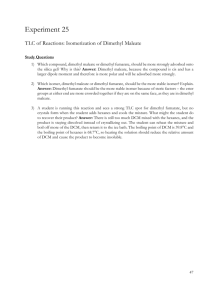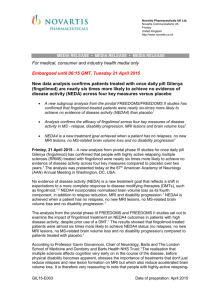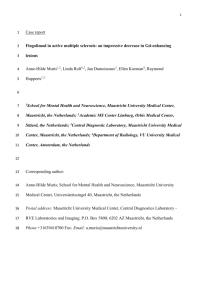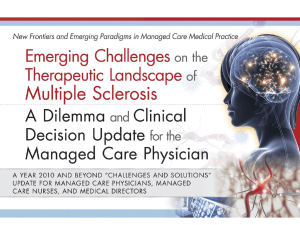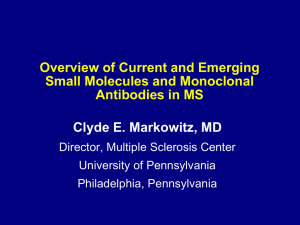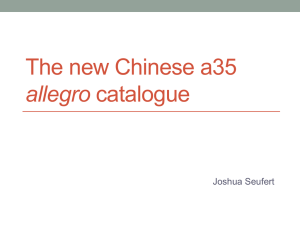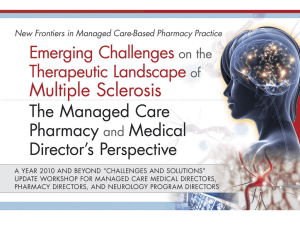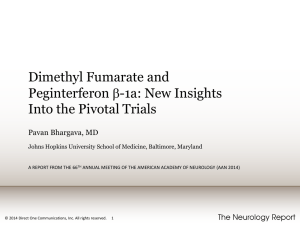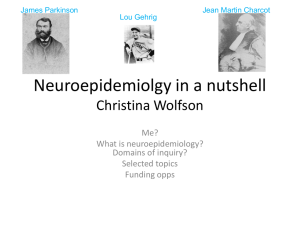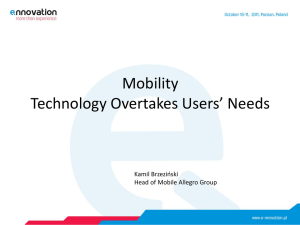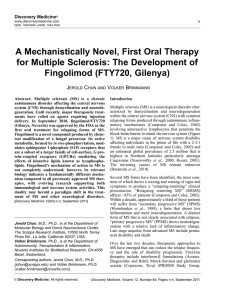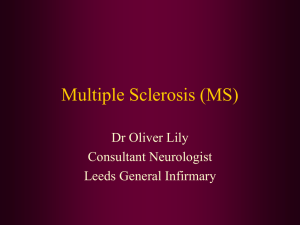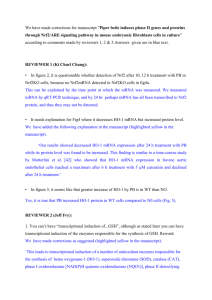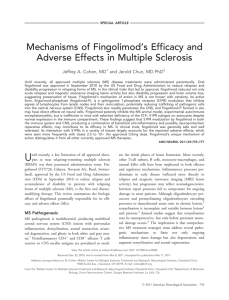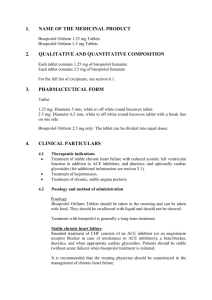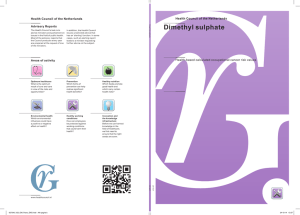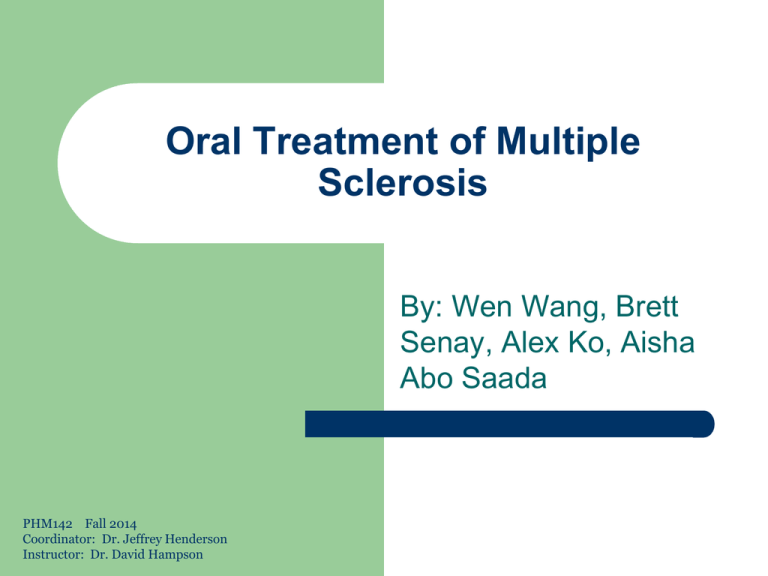
Oral Treatment of Multiple
Sclerosis
By: Wen Wang, Brett
Senay, Alex Ko, Aisha
Abo Saada
PHM142 Fall 2014
Coordinator: Dr. Jeffrey Henderson
Instructor: Dr. David Hampson
Introduction:
MS is a chronic progressive disorder
Acute symptoms of demyelination, axonal
transaction, and progressive neurodegeneration
Results in long term disability
The cause is largely unknown
Pathophysiology:
CNS inflammation and destruction of myelin
sheath of neuron due to attacks by own immune
system
loss of oligodendrocytes
Lesions in white matter
Breakdown of axon of neurons
Effected Population:
Second leading cause of disability in young
adults
Females, born/raised far north and south in
latitude, especially Scandinavian and
northern European ethnicity
Mostly females between 20-40, slightly older
in males
Treatment:
No cure for MS
Long term managed with immuno-modulating med,
limit additions of new symptoms and prevent
worsening
Gilenya (Fingolimod)
Reduces number of relapses
Slows down physical progression of MS
Dose: 0.5 mg, daily
Cost: $31,000 per year
–
Covered by most private insurance plans
How it Works
Sphingosine-1-phosphate receptor modulator
on lymphocytes
Fingolimod phosphorylated (activated) by
sphingosine kinase 2
Initially agonist, but results in internalization
of receptors
Receptor regulates the release of
lymphocytes to the blood
Side Effects
Increased risk of infection
Higher risk of infection from vaccines
Blood pressure increase
Macular edema
Headaches
Tecfidera (dimethyl fumarate)
First approved by Health Canada in April 2013
Monotherapy for relapsing-remitting MS; reduces frequency of
relapses and delays the progression of disability
Half-life of the active metabolite is short (approx. 1 hour)
May decrease lymphocyte counts
Tecfidera (dimethyl fumarate)
esterase
dimethyl fumarate
(DMF)
monomethyl fumarate
(MMF)
Dimethyl fumarate is metabolized by esterases before
reaching the systemic circulation to its primary active
metabolite, monomethyl fumarate.
Tecfidera (dimethyl fumarate)
Nuclear Erythroid 2-Related Factor 2 (Nrf2) transcriptional
pathway
ARE: antioxidant response element
GCLC: glutamate-cysteine ligase
GSH: glutathione
GstA2: glutathione S-transferase A2;
HO-1: heme-oxygenase-1
Nqo1: NADPH quinone oxidoreductase 1
MMF: monomethyl fumarate
Nrf2: nuclear factor erythroid-derived 2related factor 2
The Nrf2 pathway is involved in the cellular response to oxidative stress.
Laquinimod
Investigational agent proposed for relapseremitting MS
Once daily immunomodulator
Oral administration
Laquinimod – Mechanism of Action
Same MoA as Fingolimod
Laniquimod is phosphorylated
Modulates lymphocyte S1P (sphingosine-1phosphate)
Prevents deployment of lymphocytes from
lymphoid tissue which prevents autoimmune
attack
Crosses the blood-brain-barrier
Laquinimod – Research
2 phase III trials (ALLEGRO & BRAVO)
showed promise
ALLEGRO & BRAVO prompted a third phase
III trial (CONCERTO)
Both studies showed a reduction on disability
ALLEGRO showed an improvement in
relapse rates
Summary Slide
Multiple sclerosis (MS) causes CNS inflammation and destruction of myelin sheath
No cure for MS, treatments only slow down and delay worsening
Fingolimod is phosphorylated by sphingosine kinase 2
– Mechanism of Action: Fingolimod phosphate internalizes the sphingosine-1phosphate receptor that mediates the release of lymphocytes from the lymph
nodes
The therapeutic effects of Tecfidera (dimethyl fumarate):
– Mechanism of Action: appear to be mediated in part through the activation of
the nuclear erythroid 2-related factor 2 (Nrf2) transcriptional pathway, which
results in the upregulation of antioxidant response genes.
Laquinimod – investigational agent similar to fingolimod but not yet approved by
Health Canada, prevents deployment of lymphocytes from lymphoid tissue which
prevents autoimmune attack
References
Cohen, J. et al. (2010). Oral fingolimod or intramuscular interferon for relapsing multiple
sclerosis. New England Journal of Medicine, 362, 400-415.
Multiple Sclerosis Society of Canada. Gilenya Frequently Asked Questions. Retrieved from
http://mssociety.ca/en/treatments/treatments_updates_fingolimod.htm
Chen H, Assmann JC, Krenz A, Rahman M, Grimm M, Karsten CM, Köhl J, Offermanns S,
Wettschureck N, Schwaninger M. (2014). Hydroxycarboxylic acid receptor 2 mediates
dimethyl fumarate's protective effect in EAE. J Clin Invest. 24(5): 2188-92.
Linker RA. (2011). Fumaric acid esters exert neuroprotective effects in neuroinflammation
via activation of the Nrf2 antioxidant pathway. Brain. 134: 678-92.
Venci JV, Gandhi MA. (2013). Dimethyl fumarate (tecfidera): a new oral agent for multiple
sclerosis. Ann Pharmacother. 47(12): 1697-1702.
Rubin, Susan. (2013). Management of Multiple Sclerosis: An Overview. Disease a Month.
59: 253-260.
Bruck, W., & Wegner, C. (2011). Insight into the mechanism of laquinimod action. Journal
of the Neurological Sciences , 173-179.
Chun, J., & Hartung, H.-P. (2010). Mechanism of Action of Oral Fingolimod (FTY720) in
Multiple Sclerosis. Clinical Neuropharmacology , 91-101.
Jeffery, S. (2012, 08 09). CONCERTO: A Third Phase 3 Trial for Laquinimod in MS
.

